Will modern cars, and modern materials, age gracefully?
When we drive our cars, they collect signs of that use—patina, in collector-car speak. The latest issue of Hagerty Drivers Club magazine, in which this article first appeared, explores the delight found in such imperfect cars. To get all this wonder sent to your home, sign up for the club at this link. To read about everything patina online, click here.
***
Hagerty Drivers Club magazine sat down with member Richard Vaughan, a designer who has 30 years of experience in a variety of automotive product development roles at Ford Motor Company, General Motors, and Rivian, to ponder the question: Will Radwood-era (post-1980) cars develop patina?
Vaughan, a graduate of Detroit’s College for Creative Studies and a lifelong car enthusiast, has written six books on Rolls-Royce, Bentley, and Aston Martin and has been a concours organizer and judge for decades. He currently serves on the Advisory Team for the Detroit Concours as well as on the board of directors of the Rolls-Royce Foundation Museum and the Rolls-Royce Owners’ Club.

Hagerty: Tell us what you think patina means in the classic car hobby.
Vaughan: Patina means worn in as opposed to worn out. It’s like if you buy a Ralph Lauren leather club chair, and over the years it becomes worn in and it looks like you’ve enjoyed it, but it’s still beautiful. That’s different from being worn out. Worn out looks like something you need to throw away and replace.
Cars made before the ’80s have several sensory cues that communicate that they’re worn in: smell, touch, feel. For the interior, leather, fabric, carpet, and wood are probably the four primary materials that create these sensory perceptions. On the exterior, it’s metal and chrome. Acrylic lacquer paint was commonplace from the immediate postwar era through the ’70s. Cars had a lot of paint, and it wasn’t quite as glossy as modern paints. When you polish and polish acrylic lacquer over the years, it gets thinner and thinner, and you get those beautiful areas where you can see that someone has maybe polished through the paint a little bit. It has what I would call a luster. That changes the more you polish it, and the cars can take on a really lovely look of being worn. You can tell somebody’s loved it and they use it.
Radwood cars don’t have it?
Vaughan: You can’t get that patina because the technology just doesn’t allow it. Radwood cars all have urethane, or polyurethane, paint finishes, which is a two-stage paint: base coat, clear coat. When the clear coat fails, it starts peeling off and looks like crap. It never looks worn in; instead, it looks great until it looks bad. You’ll see the paint peeling off the clear coat in sheets.
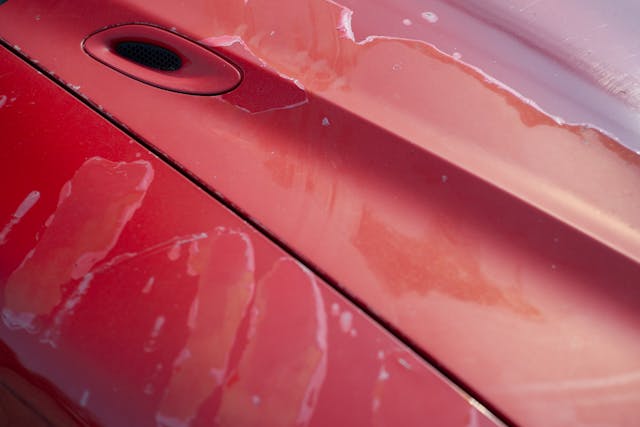
How will exterior plastic trim age?
Vaughan: Plastics for urethane bumpers and that kind of thing often are painted, but the black-molded-in-color plastics just turn gray and look awful and then you’re trying to put Armor All on it. I mean, if you ever see an old Pontiac Aztek or Chevy Avalanche where half the car is covered in that cladding and it’s really faded—you see these little, like, lines? That’s the mold flow of the liquid plastic as it enters the injection molding tool.
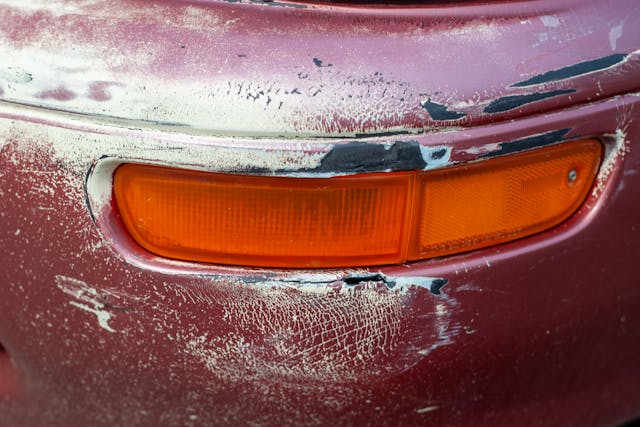
Are there any remedies?
Vaughan: The idea that you could preserve it and it’ll look like it has patina? That is not going to happen. To make the car look good, you’d have to paint the parts, which is kind of weird, as it’s a deviation from the original, but you could paint with a matte finish; it doesn’t have to be a glossy paint. But then it’s not original patina; it’s something else.

So, exterior plastics will not have patina as we know and appreciate patina?
Vaughan: It would be a compromise thing. In the ’80s and into the ’90s carmakers, especially of mass-market cars—this doesn’t apply to a Ferrari or a Bentley—but cars like a Corvette or a Pontiac 6000 STE—they use a lot of PVC—polyvinyl chloride—and a lot of polypropylene, which is the hard material that turns brittle and breaks. In the ’80s, most of that polypropylene, or PP as we call it in the industry, was painted. If you had a beige interior, they would mold the plastics in beige and they would also be painted beige. And, so, two things can happen. You can have the paint starting to separate from, or delaminate from, the substrate, or you can have the plastics getting so brittle that they break and are not repairable. When you’re shopping for a used car from that era, you have to ask: What was the climate where that car lived? If the car came from Texas, every time you take a plastic part off the car, you might as well be sure you have a replacement when you need to put it back on. A car from a place like Seattle where it’s not incredibly hot and there’s not a lot of UV damage, because there’s a lot of cloud cover, might be OK. But eventually time will get all these polypropylene parts.
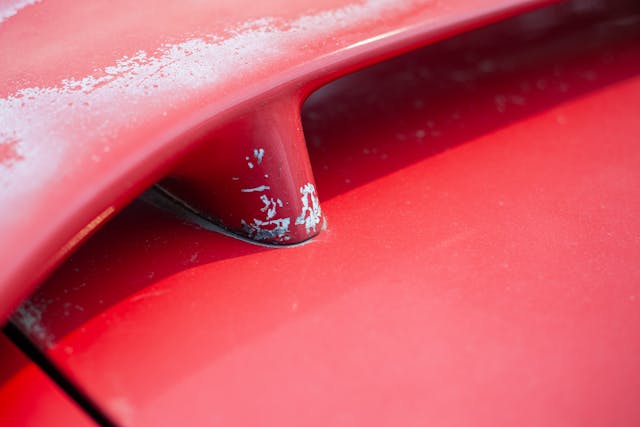
Is it possible that 25 years from now we collectively might decide that it’s charming when those 1990s plastics turn gray?
Vaughan: I’ve been wrong about a lot of things in life, but I don’t think anybody will value that.
Does that mean that in 2050 we will clearly know the difference between a patina-era and a non-patina-era car?
Vaughan: A lot of it will depend on the car. There may be within a certain car community an appreciation for some aspect of the degradation of the materials, like we do today for cars in the ’50s and ’60s that are original. But it’s going to depend on how those materials were used in a particular vehicle.
Here’s another example: leather, which people value a lot, but which has changed and evolved. If you look at a car from the ’60s or ’70s and into the ’80s, leather seating was literally leather sewn together, which can be repaired. And if it’s a really nice car with a thick hide properly dyed rather than simply sprayed with a topcoat of color, you can get a beautiful patina as the leather wears in and you start to see some of the layers of the material. These leathers didn’t have coatings to prevent moisture from getting in. So you could put a cream on the leather, what we call “hide food.”
But in the ’90s, car companies started laminating the leather to protect it and add softness. The leather is laminated to a foam scrim, or backing, to provide some initial softness when you touch the material. But over time, the foam backing starts to break down and de-laminate. And then the leather seat looks like a sleeping bag. Look at, say, a 2007 Aston Martin V8 Vantage or DB9 or an ’07 Bentley Azure convertible. You peer into the interior and you say: My goodness, these seats look terrible, loose and baggy. It’s because the foam has de-laminated and turned to dust. It’s common across most premium automakers—I have this conversation all the time with the Rolls-Royce community.
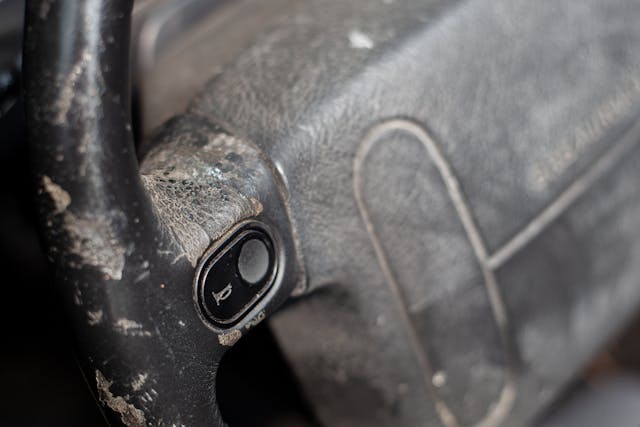
What if that coated leather cracks?
Vaughan: Putting hide food on modern leathers is a waste of time and money because the coatings are designed to prevent, to repel, absorption.
The leather that we of a certain generation loved because of the way it looked, felt, and smelled, and its incredible durability? That traditional material is not considered to have a premium haptic anymore. Today’s luxury buyer would find it to be too hard and firm to the touch. That all changed due to the consumer desire for this sensory perception. It’s also worth pointing out that the cost of leather is very high in more than mere dollars. Leather is extremely heavy.
Foam lamination is also used for vinyl. When we say vinyl, what we usually mean in the car industry is a PVC-coated cloth. And when you talk about synthetic leather that you might find in a modern upscale car like a Lucid or Rivian, that typically is polyurethane. In the business, we would always call that “PU” or “PUR” for polyurethane. And the technical term for these treatments, by the way, is polymeric films.
If we say vinyl, that’s internally [inside car companies and suppliers], because we know that the consumer doesn’t like that word, so we don’t use the word vinyl if we’re talking about the higher-end product that’s polyurethane-based, even though it is indeed just vinyl.
Everybody would consider it vinyl, but the industry often draws a distinction between PVC vinyl and PUR by calling PUR “vegan leather”—but they’re both just petroleum-based polymeric films. The main difference is that the PUR feels more like leather.
None of these plasticized interior materials is going to age well?
Vaughan: Well, that’s one benefit of PVC. It looks good and lasts forever. Everybody’s heard of MB-Tex. You can see a 50-year-old Mercedes and the seats look brand new.

Is PVC vinyl a candidate for patina?
Vaughan: No. Patina implies that it has a worn look. This stuff just doesn’t wear; it can last a very, very long time. Now, of course, like everything, there are really cheap versions where you can wear off the topcoat. But, you know, a car that has a really nice PVC vinyl will keep a new look or good condition look for an extremely long time.
You mentioned Corvette earlier. If we’re talking C4 through C8 Corvettes, in 2050, will there be aftermarket replacements for both interior and exterior plastics?
Vaughan: I think the cost of injection-molding tooling is lower and lower all the time, and 3D printing will allow people to replace parts that would have otherwise not been available. But these are going to be like-new spec. There’s no way in 2050 to make a C7 Corvette have patina as we currently perceive patina.
So, back to our earlier thesis, patina may die after 1980 …
Vaughan: I think your thesis is accurate.

***
Check out the Hagerty Media homepage so you don’t miss a single story, or better yet, bookmark it. To get our best stories delivered right to your inbox, subscribe to our newsletters.
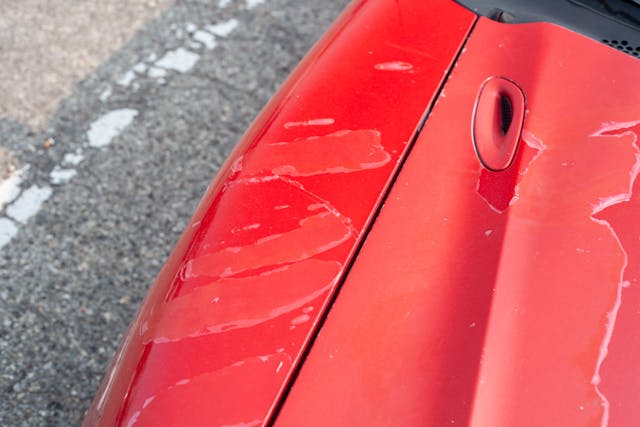


I once had a Ford engineer come to our school and talk about why and how things were done in relation to customers.
One point he made about the 80’s Fords was that they had Orange Peel in the paint. He said yes we could remove it and make it better but many customers would see the same effect on a Benz and associate it with a high quality paint job. They felt it was thicker.
He was interesting to listen to as he admitted much. He said they never fool proofed cars they had to idiot proof them,..
It is always great then someone in the industry is candid.
I think the biggest issue we will see in present cars as they age is the breakdown of their snazzy screens and infotainment systems. Their complexity almost guarantees they won’t be functional in 30-40 years. And it won’t be a matter of just replacing or rebuilding your broken speedo or tach. Maybe there will be companies that can rebuild them, but will the proper chips and other electronics be available? It would be like trying to repair a 1960s Zenith hifi system and sourcing vacuum tubes (heck my dad had problems with that with his college system he tried to rehab in the late 80s early 90s).
Richard Vaughan never ceases to amaze me when I read anything he’s said or written. He is the ultimate expert, and I was fortunate enough to observe that when he was just 10 years old! Gifted, talented, creative and now all these years later, I remember well his monkey bar sketches! Keep up the great work, Richard! So proud of you! 👏👏
My car is not perfect. Some of the chrome in the bumpers is dull, there are some minor dents which are not noticeable unless you really inspect it close. But if I take it to a car show everyone checks it out and makes nice comments about it. I wish they would give my body the nice comments my ‘74 gets.
Amen to all of this, outstanding piece and vital to anyone who has pride in their post 1980 ride.
My daily driver is a 1997 Plymouth Neon that I have owned since new. Maintaining a respectable appearance is a never ending challenge. I understand the issues with the longevity of polymers. Yes there are products that help but they are marginal at best. Replace if the part is still available or refinish if the quality of the material will respond to new paint.
In today’s world of “value added engineering” – stuff built to just barely make it through the warranty period, nothing is going to age gracefully! The crappy, chinese metals used on undercarriage components these days – the stuff that counts on ANY vehicle – aren’t going to last much more than 12 years, unless its spent its entire life in the desert Southwest. The deeper into the 21st century the vehicle model year, the worse it will be. And that’s not even scratching the surface – wait until those 36 modules age … and the low-bidder chinese wiring. Have fun with that! I’ll be driving my 20th century vehicles right into my grave.
What should be used to clean and preserve modern “leathers”? I have 2 mid-2000s Jaguars, one with 170k miles and the seats are in fantastic condition. I haven’t exactly spent hours cleaning them though. Are the 1738 different leather cleaners and preservatives on my shelf not necessary?
Regarding difficult to source replacement chips etc. My 2010 Cadillac SRX has the BCM failing. Most of the windows will not open and the interior lights stay on because it thinks the door is open. It is not the plunger it is the BCM… a lot of the features that are electronic now have a mind of their own. That BCM part was $800 up in Canada but it doesn’t matter because it has been discontinued therefore cannot even be fixed. My solution was to pull all the interior light bulbs out of their sockets and I’ll just drive this thing until it explodes.
The only ghetto part is having to open the driver’s door at the McDonald’s drive-thru to get my cup of coffee lol!
That’s sucks. I also have a failed BCM and only a dealer can program it screw electronics
I know your article is about patina and finishes but I think the bigger question is will the electronics
survive and will the car still function after 30 or 40 years ?
long article to state the obvious. patina will be regulated to earlier cars. any 80s onward cars that are collectable will have to be handled differently. I for one think if i still have my RM wagon years later, i’d be more than happy to completely customize the interior since 90s era GM interiors aren’t exactly quality and even now they’re hard to find ones that the interior isn’t starting to get brittle and crack and fade.
With 3D printing becoming more and more inexpensive, one’s imagination is the limit to what you can do to your ride’s look.
Nobody knows. All classic cars went through their disposable phase.